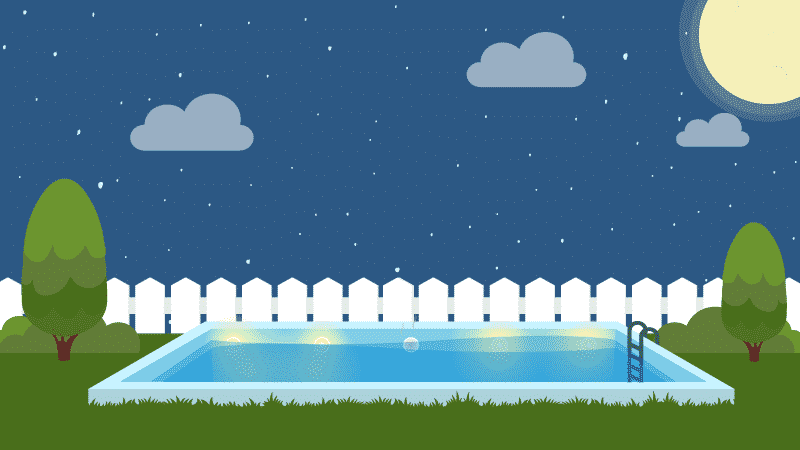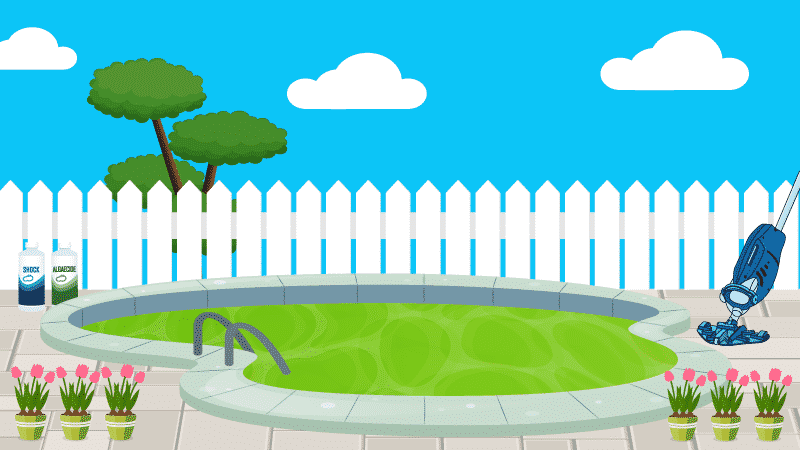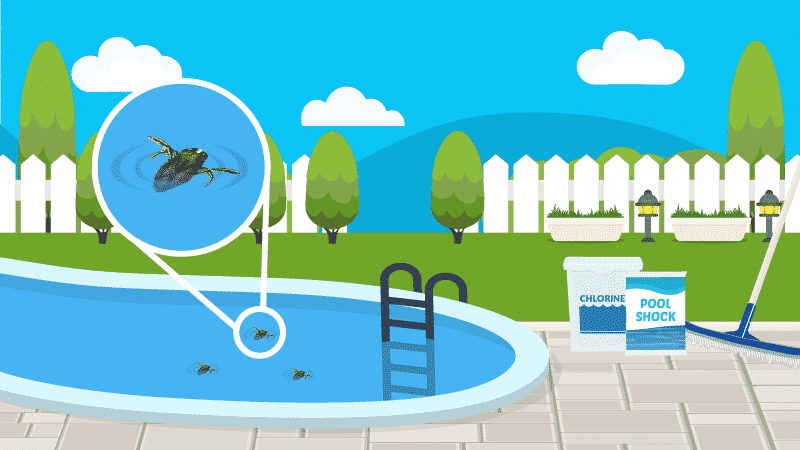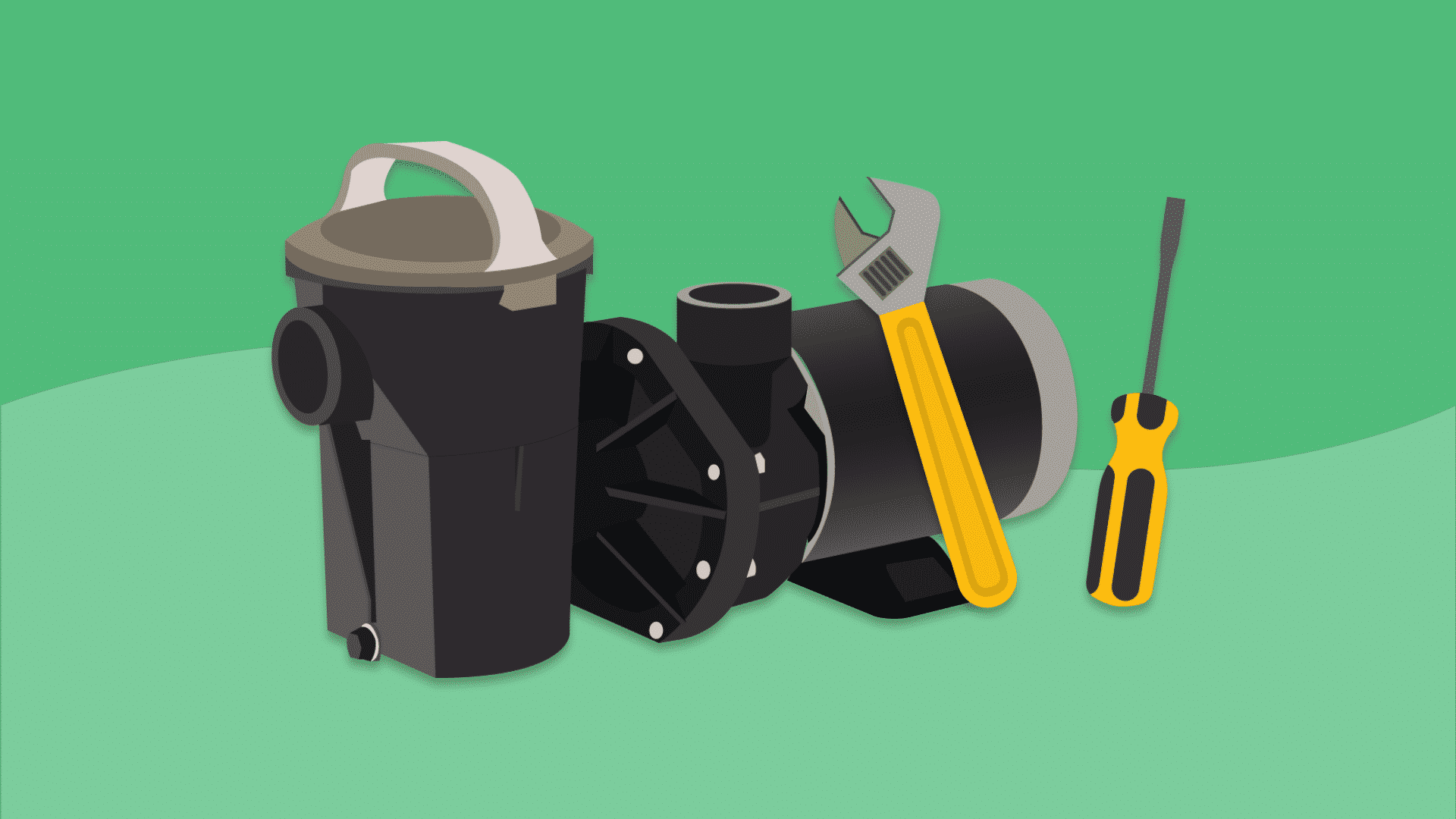How to Kill Black Algae in Your Pool
It’s bad enough to discover your pool is infected with regular old green algae. Luckily, that’s usually pretty simple to address. But if you discover black algae in your pool, get ready because you have some work to do to get your pool back to normal. And for safety’s sake, no one can swim in it until you do.
Stop wasting time and money with confusing water chemistry and maintenance. Our effortless system guarantees to keep your pool balanced, sanitized, and crystal clear all year. Works for all pools including saltwater.
Why Do You Have Black Algae in Your Pool?
Simple. Someone swam in a natural body of water like a river, pond, lake, or ocean, didn’t wash their swimwear afterward, and then wore that same swimwear into your pool.
Maybe that was you, and you did remember to wash your swimwear in between, but forgot about that inner tube you used to float down the river, and then tossed it into your pool unwashed. You just put out the welcome mat for black algae in your pool.
It’s less likely, but black algae can also enter your pool via airborne spores.
Now what? Well, the first step to getting rid of black algae is understanding what it is, because guess what? It’s not algae at all.
What is Black Algae?
True algae is an aquatic plant belonging to a group that includes everything from single-celled organisms to seaweed. This is why when you think of algae, you think of it as being something green—it usually is.
Like most plants, green algae contains chlorophyll, the pigment that gives it its green color. Chlorophyll is also the substance that allows a plant to perform photosynthesis, the process by which the plant uses light to synthesize food from carbon dioxide and water.
What we call black algae is actually a bacteria. Specifically, a cyanobacteria, which refers to blue-green algae, hence the cyan part of its name.
So if black algae is cyanobacteria, which is blue-green in color, why is it black?
Cyanobacteria contains chlorophyll, which contributes to its blue-green color. But it can also contain other water-soluble pigments that, when combined with the blue-green pigment, make the bacteria appear black.
Is Black Algae Harmful?
In a word, yes. It can be. The emphasis of this danger is usually placed on blue-green algae, though.
Cyanobacteria blooms in natural bodies of water can kill other organisms and animals that live in that water by blocking sunlight and hoarding oxygen and other nutrients. This isn’t something you need to worry about in your pool.
But cyanobacteria also make cyanotoxins, which are among the most powerful natural poisons in the world. They can make you, your pets, and any other animals that might find their way into your pool sick.
Just swimming in water infected with black algae can be enough to cause illness. But the probability and severity of illness is increased if you accidentally drink infected water.
If you have black algae in your pool, and your kids accidentally swallow pool water while they’re horsing around, they could experience anything from nausea and stomach cramps to liver damage. And have you ever seen your dog take a drink from the pool? They’re in just as much danger of becoming sick if the water is infected with black algae.
You must be able to identify black algae as soon as it appears, and take immediate action to get rid of it.
How to Recognize Black Algae in Your Pool
So first, it’s not really algae, but cyanobacteria. And what does it look like? Mold. No wonder this stuff is so hard to kill! It’s like a chameleon!
Seriously, if you notice something starting to form on your pool’s surfaces, and it looks like a bunch of tiny black dots or big clumps of mold, you may have black algae in your pool. And because it’s cyanobacteria, those clumps may actually look more blue-green than black.
Also, black algae seldom forms in pools with fiberglass or vinyl liners. It’s more at home in concrete, plaster, or gunite pools because they’re porous surfaces the organism can really latch onto, and even “grow roots” past the surface.
A few other ways to recognize black algae in your pool:
- The black or blue-green spots and clumps have raised heads, and are attached to the pool’s surface. They don’t float freely in the water.
- It establishes itself in areas where the pool surface is rough and it can really grab hold.
- It doesn’t brush off the wall easily with your regular pool brush. Sometimes, even with an algae brush.
- It can be scraped off the pool’s surface, even though it may take some elbow grease. Pool stains cannot be scraped off.
- You may find it even if you’re vigilant about keeping your pool water balanced, sanitized, and filtered. Again, it enters your pool from external natural water sources.
Recognizing it means you can take the right steps to get rid of it because treating black algae like green algae won’t work. You need to get out the big guns.
How To Kill Black Algae
Plain green algae is pretty easy to kill because it’s a plant, and anyone without a green thumb can attest that you can kill a plant just by looking at it the wrong way. Or is that just us?
Anyway, the fact that black algae in your pool is actually bacteria is what makes it so hardy and hard to kill. And you thought that was just a movie.
The good news is, it’s not impossible to kill. It will only take a little more effort and persistence on your part.
Before you begin, gather the supplies you’ll need:
- backwash hose (if necessary)
- filter cleaner
- filter sand (if needed)
- DE powder (if needed)
- replacement filter cartridge (if needed)
- test strips or liquid test kit
- algae brush
- chemical-resistant gloves
- safety goggles
- chlorine tablets
- chlorine tablet holder
- telescoping pole
- calcium hypochlorite shock
Make sure you stretch before you start, because you’re going to get quite a workout.
These safety glasses offer robust protection to resist scratches and an anti-fog coating to prevent lens clouding.
1. Clean the Filter
If you have black algae in your pool, you have black algae in your filter. If there’s only a small amount of black algae in the pool, you can probably get away with backwashing your pool filter (for sand or DE filters), or rinsing the filter cartridge.
If the algae problem is extensive, use a filter cleaner rather than just plain water.
With as difficult as black algae is to get rid of, though, you may also want to consider completely replacing the filter medium or cartridge. Start over fresh so you know for sure there’s not one speck of black algae lurking in your filter, waiting to reinfect your pool after you’ve gone to all the trouble to get rid of it.
Clean out your pool filter overnight to keep your water crystal clear and ready for swimming, works with all pool types and filter systems.
2. Test and Balance the Water
Ensuring your pool water levels are where they need to be helps determine how much how much pool shock to use when you get to that step, and will help the shock kill the black algae in your pool.
You can use test strips or a liquid test kit. You don’t need to concern yourself with levels for things like calcium hardness right now. Focus on alkalinity, pH, and sanitizer, and shoot for optimal levels.
- alkalinity: 100 ppm to 150 ppm, with 125 ppm being ideal
- pH: 7.4 to 7.6
- chlorine: 1 ppm to 3 ppm (or the proper range for whatever sanitizer you use)
If those levels are out of whack, adjust them before proceeding.
This is a proven way to make the water less acidic when swimming in pools. This chemical helps maintain the right level of pH.
3. Brush the Pool
Wait, maybe we didn’t make that clear. You’ll need to BRUSH the pool. Brush it like you’ve never brushed it before.
Your usual, everyday pool brush won’t do. You need a stainless-steel-bristled brush to get into those cracks and crevices and really dig that black algae out of its hiding places. That is, unless you have a fiberglass or vinyl liner. In that case, use a nylon-bristled brush, and about twice as much elbow grease.
Brushing the black algae loosens it from the pool’s surfaces and puts it into the water where the shock will be able to kill it.
This brush helps remove dirt, contaminants, bacteria, and algae from porous surfaces. For unpainted concrete or gunite pools only.
4. Scrub the Black Algae Spots
No matter how well you just brushed your pool, you’ll probably still see some spots where the black algae just didn’t come loose. Now you need to get up close and personal.
You can use a putty knife, a pumice stone, or even a hand-held wire brush to scrub the remaining black algae off the pool’s surfaces. We like to use chlorine tablets because now only do they offer a scrubbing surface, you’re also applying chlorine directly, which can start killing the bacteria while you scrub.
- Put on your chemical-resistant gloves and protective eyewear.
- Break a 3-inch chlorine tablet in half.
- Hold it firmly, and scrub the black algae with the broken edge.
For those spots you can’t reach:
- Place one half of the tablet in a chlorine tablet holder with the broken portion facing outward.
- Attach the holder to your telescoping pole.
- Scrub the black algae spots you’re unable to reach by hand.
Don’t worry if you don’t get every speck of black algae off the pool surfaces because next you’re going to …
Essential Pool Cleaning Equipment: Designed to clean stains in pools caused by algae.
5. Brush the Pool Again!
Didn’t we say you’d need to stretch before you started? If your arms are cramping now, take a break, eat a banana to give your muscles some potassium, and then get back to work. You’re not done yet.
6. Quadruple Shock the Pool
Did we mention black algae is difficult to kill? A regular dose of shock won’t be nearly enough to get rid of it. Now that you’ve brushed as much gunk off your pool’s surfaces as you can, you need to kill all that nasty stuff floating in the water.
Follow the manufacturer’s instructions to determine the correct dose for your pool’s volume, then multiply that by four. Not sure how much water your pool holds? You can use our pool calculator to figure it out.
 Rectangle
Rectangle
 Round
Round
Even if you don’t normally use it, we highly recommend using calcium hypochlorite shock to kill the black algae in your pool. Nothing else will work as well.
Tip: Place all your pool maintenance equipment—the algae brush, the tablet holder, the leaf skimmer if you’ve used it recently, everything—in the shallow end of the pool to sanitize it during the shocking process.
Important: Remember to shock your pool at dusk or night. If you shock during the day, the sun will eat up most of the chlorine before it has a chance to kill the algae.
This fast-acting, quick-dissolving swimming pool shock kills bacteria, controls algae, and destroys organic contaminants in pools.
7. Run the Pump
To get the shock dispersed so it can do its job and kill all the black algae in your pool, run the pump for 24 hours. You may come back to cloudy water, but that’s perfectly normal.
“But wait!” you say. “Isn’t this going to put black algae right back into the filter I just cleaned a while ago?!”
Yes. But don’t worry because thanks to the shock, it will be dying. And—spoiler alert!—you’re going to clean the filter a second time, though not as rigorously.
8. Brush the Pool
Déjà vu! During that 24-hour period while the chlorine level in the water is so high, brush the surfaces at least two more times—preferably three or four times—to get any remaining black algae off the walls and floor of your pool.
9. Clean the Filter
The first time you cleaned the filter was to get any live bacteria out of the filter. When you ran the pump after shocking, the filter probably accumulated bits of black algae—like it was supposed to—but it would have been dying thanks to the superchlorination treatment.
So this time, no need to replace any medium or cartridge. You can simply backwash your sand or DE filter, or rinse the cartridge. But to be on the safe side, because you can’t be too careful when it comes to dealing with black algae in your pool, we recommend using a filter cleaner.
10. Shock the Pool Again, If Necessary
If, after a quadruple shocking, running the pump for 24 hours, brushing the pool multiple times, and cleaning the filter a second time, you still see any remnants of black algae in your pool, shock it again.
Only this time, use double the dose. Then get that brush ready. You know what’s coming.
When dealing with pool or hot tub chemicals, you need good gloves to provide you with the good hand protection.
11. Run the Pump Again
This time, you could probably get away with running it for 8 or 12 hours, but again, we’re talking about black algae, so we recommend running it for another 24 hours.
12. Brush the Pool
By now, you should be able to beat Sylvester Stallone in an arm wrestling competition. But this really is the only way to get all of that nasty bacteria off your pool’s surfaces. Once it gets rooted in there, it’s more difficult to remove than any other type of algae, mold, or bacteria that may befall your pool.
If you want to make sure it doesn’t come back, do not, under any circumstances, skip the brushing.
13. Test and Balance the Pool Water
After all that work, your pool should now be free of black algae. Test the water, and then add the appropriate chemicals as needed to bring all the levels back to where they should be.
This complete water testing kit helps keep your pool or hot tub clean and safe to swim in, with easy-to-follow color instructions and all the supplies you need in one box.
14. Keep an Eye Out for Stragglers
Over the next few days (weeks, really), keep a close eye on your pool for any signs of black algae returning. It’s possible that, even with all that shocking and brushing, you may have missed a teeny-tiny bit that will start to grow again. We’re talking about bacteria, remember. It’s microscopic.
If you do see a small spot reappear, brush it off, scrub the spot with a broken chlorine tablet, and then give your pool a normal dose of shock.
After all that, we’re betting you don’t ever want to see the smallest spot of black algae in your pool again, right? So make sure you do everything you can to keep it out.
Stock up and save money on chlorine tablets for the season by getting the standard 3-inch stabilized chlorine pucks.
How To Prevent Black Algae from Invading Your Pool
The first line of defense is to always, always wash your swimsuits, aquatic shoes, toys, anything you may have used in a natural body of water before you allow it to even touch your pool.
And just rinsing isn’t enough. Everything must be washed. It’s fine to put swimwear through your washing machine, but pool toys must be scrubbed with a solution of one tablespoon of bleach per gallon of water to not only clean, but sanitize them. You can also use a spray cleaner that contains bleach. Either way, rinse everything thoroughly before putting it back in the pool.
After those preventive measures, keeping your pool properly balanced and sanitized is the next step to keeping all forms of pool algae from growing.
- Keep your alkalinity, pH, and sanitizer levels in the recommended ranges at all times.
- Run your pump and filter for 8 to 12 hours a day, every day, all season long.
- Keep your pool clean by regularly vacuuming and brushing it.
- Shock your pool at least every week. More often if you’re using it more often, or more people are swimming in it, or both.
- Keep your pool equipment clean, including skimmers, hoses, ladders, steps, the diving board, slides, solar blankets and your safety cover.
- Keep your pool accessories clean, including pool toys, floats, drink holders, floating speakers, and anything else that touches your pool water.
- Require anyone who uses your pool to rinse off first. If they refuse, show them these instructions and tell them that if they cause another case of black algae in your pool, they’ll be doing all the brushing.
You Can See Clearly Now, the Algae’s Gone!
Whew! We’re tired after just putting all this down, so we can imagine how exhausted you must be! It’ll be worth it, though, to kill the black algae in your pool and keep it from returning.
More importantly, you’ll be keeping your family and pets safe, and maintaining a pool that’s clean, sanitary, and fun to use without any worries.
Happy Swimming!
3 Ways We Can Help With Your Pool
- The Pool Care Handbook: An illustrated guide to DIY pool care, including water chemistry, maintenance, troubleshooting, and more.
- The Pool Care Video Course: You’ll get 30+ step-by-step videos and a downloadable guide with everything you need to know about pool maintenance.
- The Pool Care App: Enter your water test results. Get a custom treatment plan. Know exactly what chemicals to add to keep your pool clear.






















